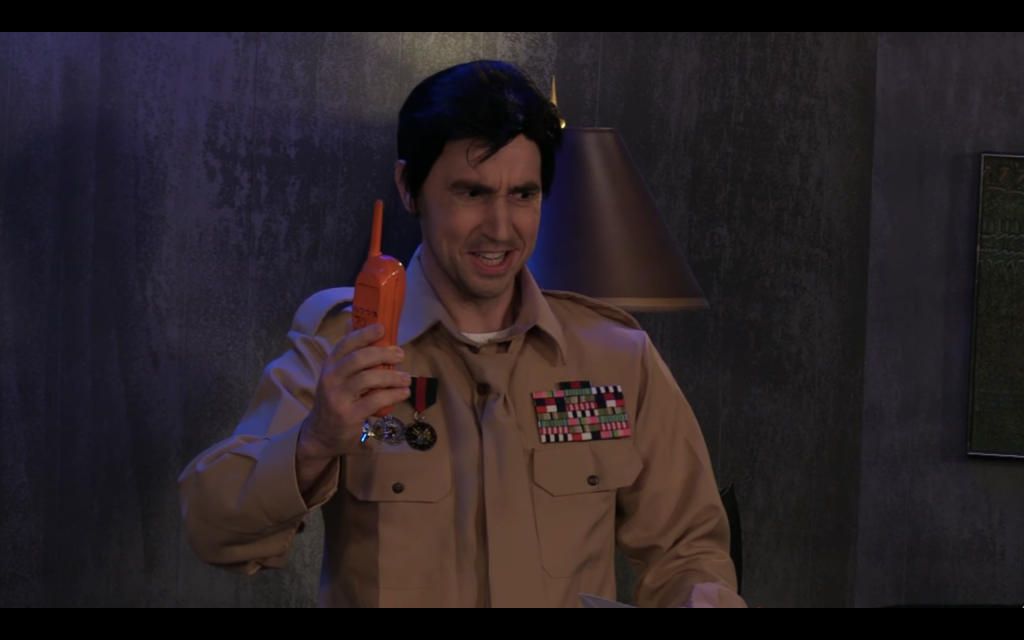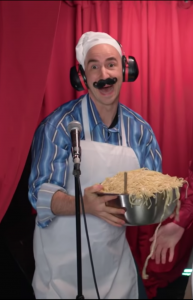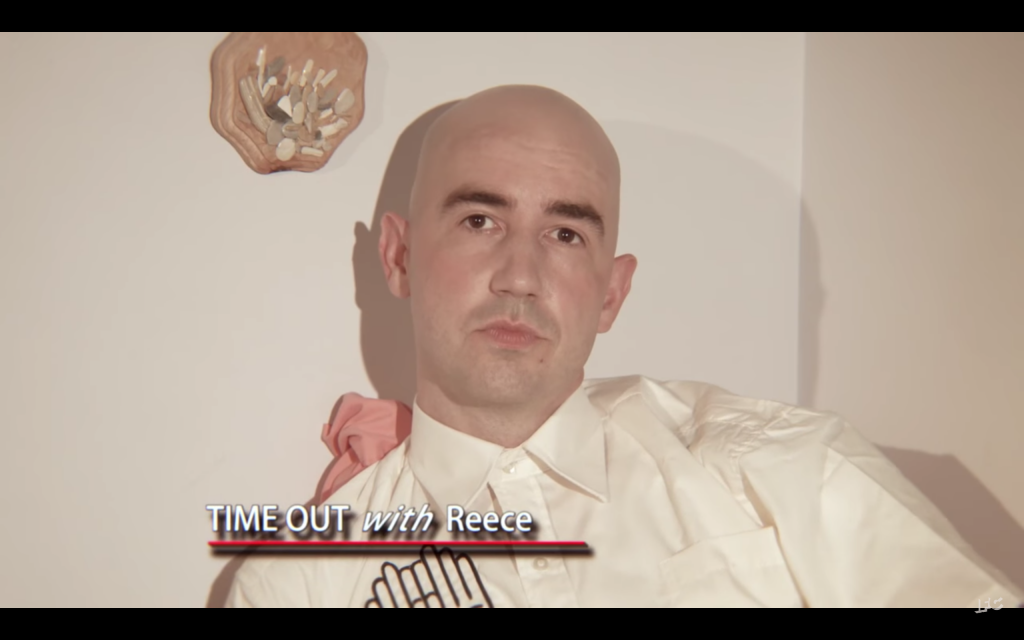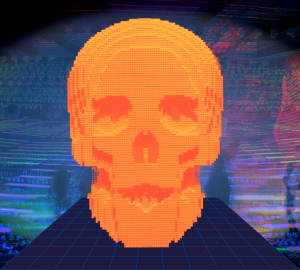Ben O’Brien talks ‘Reverse Transmission,’ ‘Wham City Comedy’ and the joy of collaboration

Ben O’Brien is an interdisciplinary artist and one of the founding members of AB Video Solutions, the production company behind “The Mirror,” on IFC, and the “Cry of Mann,” on Adult Swim. The Connector got a chance to speak with O’Brien about what goes into making a Wham City Comedy/AB Video Solutions production, what makes a fruitful collaboration and how art school has influenced his work.
The Connector: First of all, I would like to say congrats on “Reverse Transmission,” I enjoyed it a lot.
O’Brien: Thank you. I’m really excited about it.
The Connector: I liked your break-out role as the bathroom door reader.
O’Brien: [laughs] yeah, that’s my big moment. Actually, I get to play a real character in chapter three, but I play a lot of the auxiliary voices.
The Connector: I thought that was a very eerie moment because it solidifies when you notice how much the technology in the story permeates everything.
O’Brien: Yeah, for sure.
The Connector: So, I know you guys must be extremely busy with everything you have coming out soon. Is that daunting working on so many different projects?
O’Brien: It’s incredibly daunting. [laughs] We are in Atlanta right now at the Adult Swim offices getting ready to do the second season of our show, “Cry of Mann,” called, “Call of Warr,” and it is an all encompassing project. It takes all of our focus and energy for like three weeks straight.
It’s basically like we’re doing five, one-hour live plays that we’re filming on adultswim.com and people can call in and talk to our characters. So, it takes a lot of energy because we are doing all aspects of production, as well as performing, having to remember scripts, directing and organizing everything. It’s almost impossible, but we somehow do it.
And then, also I have the release of “Reverse Transmission,” which comes out [Oct. 24]. So, today I have been trying to work on two projects like that, and it’s a lot, but it’s also good. We want things happening, you know, so I feel very grateful.
The Connector: Those are definitely good problems to have.
O’Brien: Yes.
The Connector: I would imagine that doing something like, “Cry of Mann,” would be incredibly demanding by itself, but to have everything moving all at once like that must be difficult.
O’Brien” It’s one of those moments where you forget that you’re working on something that’s so stupid [laughs]. We’re taking it so seriously, even though it is really goofy and kind of silly. We are all spending so much time making sure that our characters are correct to the point where we’re losing our minds. So, it is kind of funny in and of itself, just putting that much effort into something that’s so silly.
The Connector: What has been interesting in particular about working on “Reverse Transmission,” since it was a radio-play? What was unique about directing that?
O’Brien: It was an entirely new format that I had never worked in before. I had always been kind of drawn to audio. I like how freeing it is because you don’t have to worry about the visuals. And so, that can be a gift and a curse, but in a lot of ways production wise it’s smoother. The pre-production is shorter and the days where you’re taping you don’t have to worry about shots, setups or locations that much — it feels very freeing in a lot of ways.
And, at the same time, it being a new format, there was a learning curve in terms of going from normally being very visual in what we make to being limited to having to try to create these moments. We wanted to create these powerful, interesting, creepy or scary moments, but only having audio and actor performances. We learned a lot, and I’ve been really excited by it. I definitely want to keep working on audio projects.
The Connector: It seems like that would definitely push your limits too, because you guys are normally so visual heavy. Trying to fill in the gaps where you can’t see things must have been fun to try and tackle.
O’Brien: Yeah, I think it makes you better at visuals to take them away. It’s like a homework assignment almost. How do we get those same feelings or experiences without our main crutch? We had a rule that we were trying to have some big moment in each chapter — that freaked you out or made you feel something.
So, that was the challenge we gave ourselves, and to do that, my brother and I — especially in the directing — tried to focus on getting the actors to feel very natural. So when they went through these emotions, you get these real natural characters and you put them through bizarre situations and let them react in a realistic, natural way. And, hopefully if we can create these interesting or strange situations, we’ll get that effect like you’re listening in on someone experiencing something and give you that creepy or funny feeling.
The Connector: That is very interesting especially because that stipulation does sound exactly like something you would get as an art school assignment — make a visual project using only sound.
O’Brien: [laughs] That’s true.
The Connector: Speaking of projects like this in general, for Wham City and AB (Video Solutions), ideas like, “Reverse Transmission,” are very dense as far as deciphering information and there’s a lot that you can pick apart. In constructing an idea like that, how you guys go from initial inspiration to final product? What leads you to decide that this is an idea you really want to go forward with?
O’Brien: It depends on who is leading it. Being a collaborative group, it isn’t like we take turns. But, we all have our own things going on, and a Robby (Rackleff) project is different than an Alan (Resnick) project and is also different from my projects. So, it depends on the situation, but one thing we do often is collaborate on our pitches and ideas. Someone will say, “What do you think about these different ideas?” and we’ll narrow it down.

When we are doing the pitching process, the best way to do it is to send a bunch of ideas to someone, a network or a company that might be interested in something, and then they help narrow it down further. They’ll say, “Give us something more fleshed out with this one, this is what we like.”
There’s kind of a lottery process getting to a point where we actually have something to focus in on. But, one of the reasons that we all work together is that we just really like to mix humor with really serious or dark existential problems. And, we also don’t like to be obvious. We like to obfuscate. That’s the kind of stuff that we enjoy, so in the process of developing and writing we will add as many layers as we can and try to hold onto the integrity of what we’re trying to do as much as possible. And, I think one of the most important things is that we don’t underestimate our viewers, and we don’t treat them like they’re stupid, or need everything explained to them.
A lot of places are obsessed with that. They get so freaked out by something that isn’t very accessible to everybody that they end up dumbing it down in certain ways. I think that making the choice not to do that allows us to more easily create layers and insert symbolism and not be completely obvious. I also think that people really appreciate that because we kind of live in a world where a lot of our media and entertainment is obvious and very self-explanatory. You don’t have to engage your brain that much when you’re watching it. And, I think the people that appreciate that, but there are people who don’t want that. But, that’s what we like so that’s what we try to create.
The Connector: There are definitely people that aren’t into that, but the people that are, are voraciously so. And, that is also interesting that you’d say that the sensibility of horror and comedy or the juxtaposition of humor and more serious stuff is kind of what brings you guys together as a group to begin with.
O’Brien: Yeah, we are also all touring performers of comedy in the group, and that’s how we started working together, doing both that, and video. I know I was attracted to working with Robby (Rackleff) and Alan (Resnick) early on because of what they make. I just genuinely like them as artists so much. I get excited by what they’re thinking about and what they’re going to do. It makes for a really fruitful collaboration, when we actually appreciate each other, you know [laughs]. So, I think that’s a big part of it.
After working and performing with each other for so long, we get each other in that way and we understand what the other person is going for. So, I think we connected a lot on style and comedy in certain ways. Not to say that I think I have a very different style from Alan and Robby, but I think they lean more towards horror naturally and I lean more towards comedy and jokes. So, there are differences, but like I said we just know each other so well at this point.
The Connector: It’s nice that you have a rock like that and having a group of people like that is super important. How do you think that — both as a student and a teacher — that your art school experience has shaped the work you do now? Because, if I’m correct you guys met at State University of New York (SUNY) Purchase College and that was sort of the impetus for Wham City.
O’Brien: Only Alan and I actually met in college. Wham City Comedy has kind of a confusing history because it’s a larger collective of musicians and people doing a lot of different types of things in Baltimore and we are just a small faction of that. It used to be bigger and had a lot of different people in it. Over the years it became, Alan, Robby and I, and now Cricket Arrison is also in it.
In college, I knew Alan and then I met Robby and Cricket in Baltimore. SUNY Purchase was an interesting place because it’s a cheap school and it’s really close to New York City. And, it’s kind of the art SUNY school, so it was very scrappy. But, I think a pretty large group of people met and had a similar energy of wanting to collaborate and make work, and they followed that to Baltimore. Then, I showed up a few years later when they were kind of set up there and we started doing comedy. But, in terms of what you were saying, can I get the overall question again?
The Connector: How do you feel like your art school experience, as a student and a teacher, has influenced your work?
O’Brien: That’s right. For me, I honestly wasn’t that great of a student. I didn’t really know what I wanted to do at that time. And, it wasn’t until I got out of school that I started to find the things I was excited about like video, film and performance. But, being a teacher has made me so much better of an artist because it’s forced me to think really critically about film and video and, what I love about it — what is beautiful about it — and what makes it a unique art form. Also, just as a public speaker having to communicate those ideas to students and understand what it’s like for other people who don’t have the same experience that I do, or don’t have the same understanding of that language, and how to explain that and engage people.
That has helped me become a much better director and working with people in general has become easier because of that. Your confidence goes up when you’re studying something [laughs] and lecturing about it all the time, so it has been huge. I love teaching. It’s really exciting.
The Connector: I thought that was super interesting that everyone in the group seems to have some kind of art school background, and I know that you in particular went back to teach at Maryland Institute College of Art (MICA), right?
O’Brien: Yes. I teach in the film and video department at MICA. I live in Los Angeles now, but I teach their pre-college course over the summer. I was an adjunct there for about three or four years.
The Connector: Do you ever get any fans that show up to class and don’t realize it’s you yet, or people who take those classes specifically to get you as a professor?
O’Brien: Yeah that does happen. A lot of the students, especially since they are already weirdo art students, will have seen some of our work, or will have taken the class knowing — which is fun. It is a nice moment in my life where I’m making work that appeals to younger people, and I know it won’t always be that way — but it’s nice because the students pay attention a little more when their teacher is making something that they can understand or appreciate. I think it helps them pay attention a little bit and become excited. I definitely know that doesn’t last forever though [laughs]. I won’t always be making work that 18 year-olds or 19 year-olds may have seen or enjoyed. But, right now I am trying to enjoy that aspect of teaching.
The Connector: Getting back to Wham City Comedy as a collective, I was watching a video from the Wham City Lecture series on YouTube, and there was a lecture from Connor Kizer where he talks about, “The Hope of Television,” and he spells out what he believes is the future of TV and he describes it as “Sandbox TV or, choose-your-own-adventure-television.” I thought that was particularly interesting because the way he described it, it seemed as though he was explaining exactly what the, “Cry of Mann,” would come to be, and in essence when I think about it, a lot of the AB (Video Solutions) projects in particular, have these elements of being dropped into a story and affecting it in some way — even if it’s not directly. Is that something that is just a shared sensibility that you guys enjoy about storytelling and that is why it comes through in a lot of your projects, or is that sort of a conscious inspiration when you go into making things?
O’Brien: I think if you look at our live comedy and our video work we are very interactive with the audience. With our live comedy, we’re very aggressive with the audience [laughs] but always in a playful and fun way. Not to violate, but to get people to actually be involved with the show. And, that’s something that just kind of happened. I don’t think we had a conversation that was like, “Let’s create interactive work that engages our viewers in a really intense way.” It’s just kind of new.
There’s this new ability with the internet and technology to able to include the audience in a way you haven’t before. And, I think that excites us partially because that’s what we would want If we were the audience. I don’t know honestly. Sometimes I ask myself that, but I know that it partially goes hand-in-hand with having the layers that you were talking about earlier and hidden things. Hiding things is sort of winking at the viewer and interacting with the viewer. I think we are drawn to that, and from that, we’ve also been labeled as experimental [laughs].
I guess we are always trying to push the form and experiment with technology and interacting with the audience and stuff. We’re also very, very appreciative of having fans. So, I think part of that is exciting to us to give them something that is more than just something they watch for 10 minutes and then forget about. We want to make an impact, we want to connect with people.

The Connector: Yeah, that makes sense. I was curious because when I first watched “Cry of Mann,” I saw that video not long afterwards and I thought it was kind of eerie that exactly what he explained seemed to be what the show was, and he also had a major part in it. So, it definitely seemed relevant. And, I would say that is how I feel about your work in general you guys are out in front of everything especially with, “Reverse Transmission,” it’s all unconventional and out there.
Moving forward, what is some advice you might give to art students at SCAD or wherever that want to make their own collective?
O’Brien: What I usually tell people is to find the others that want the same thing as you. Artists that you really admire that share a sense of humor or, you share something with — especially artists that you genuinely like. Then, try to reach out to them and create some big stupid project together. Collaborating is the way to do it. It is hard for a lot of people but, I would just say start practicing. I always thought collaborating was a good way to stay in touch with other artists that I really liked. So, I would create whole projects because I wanted to work with these people, or be able to involve myself in an art scene and stuff like that.
The Connector: This is kind of a side-note but, I saw you guys after the show at the Mercury Lounge in New York, and I forgot to mention that two of my favorite music videos of all time are “The Tower” (Wye Oak) and “Woof Woof” (Dan Deacon).
O’Brien: Oh, thank you.
The Connector: I was curious though, is “Showbeast,’”off of YouTube? Because I was looking for it during my research but I could only find the music videos for Carpark Records like, “Woof Woof.”
O’Brien: I have to put “Showbeast” back up there. I took it down just for a second, but I keep meaning to put it back. “Woof Woof,” should definitely still be on Carpark’s YouTube, but I’m going to put that back up when I get an opportunity.
The Connector: Is “Showbeast,” the precursor to everything for you? Was that a collaborative art school project?
O’Brien: It was the first thing I did as soon as I left art school. That was kind of thing I was talking about. I left art school, I was living in Oakland, California with some friends and I wanted to stay in touch with my friends that moved to Baltimore and just have a big fun project to work on. So, I came up with “Showbeast.” I thought it was a great opportunity to work with new artists and all these other artists and collaborate. It was a great project because it was very forgiving of mistakes and lack of skill. So, basically what I did was create a safe-space for me to learn how to do everything like make films and act and everything else.
The Connector: That seems like an important lesson for people in general. Your initial projects, especially when you are trying to get your feet on the ground, should be something that leaves room for mistakes.
O’Brien: The learning is funny on the show. And, the crappiness of it was always kind of fun, but it really allowed us a lot of space to experiment and be bad [laughs] and we were just kind of laughing at it ourselves so people should think about that more when they’re making things.
The Connector: Now, I know that many artists including myself have trouble with looking back on older projects because there is the sense that it could have been better or it is not good enough. Many people even experience this right after they have completed something, where they see all of these mistakes that no one else really does. Do you ever look back on any of your projects that way?
O’Brien: Luckily I’ve never had that problem, and I know a lot of people who do look at their old work and hate it, but I think, “Showbeast” for example, is nostalgic for me. And, because I’m such a collaborative artist I think it creates a shell around me that I don’t feel like it’s all on me. I can just kind of get excited about the project and appreciate it. I generally look back and feel bad about my own work for that reason. I look back on my life and feel bad about everything else, but not generally what we’ve made.
I will look back on “Unedited Footage of a Bear,” or something and think, “Oh wow, we made a lot of mistakes.” I’ll see more mistakes or problems, but film projects really become an experience and a fond memory. They take over your life when you’re in them and if you’re with good people and having a good time you always associate them with that feeling. So, I appreciate them even though I can look back and think, “Ah, that was crappier than I thought,” or, “We really should have done better sound,” and all these things that seem obvious to me now. But no, I enjoy watching old stuff sometimes.
The Connector: That definitely is nice. I think a big element there is, like you said, that the collaboration factor helps make it a fond memory regardless of how the show actually goes.
O’Brien: Yeah, I wish I had said it exactly like that and didn’t ramble so, just write that down and that’s what I said [laughs].
Get “Reverse Transmission,” on Audible now, and follow Wham City Comedy on social media if you’d like more information on their upcoming projects.






















